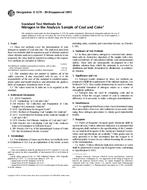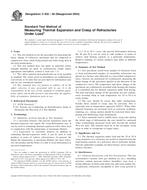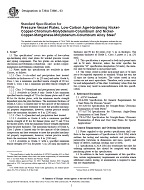1.1 This specification covers requirements and method of testing for materials, dimensions, hydrostatic burst strength, chemical resistance, adhesion strength and tensile strength properties for cured-in-place (CIP) pipe liners installed into existing metallic gas pipes, 3/4 to 48 in. nominal pipe size, for renewal purposes. The maximum allowable operating pressure (MAOP) of such renewed gas pipe shall not exceed a pressure of 300 psig (2060 kPa). The cured-in-place pipe liners covered by this specification are intended for use in pipelines transporting natural gas, petroleum fuels (propane-air and propane-butane vapor mixtures), and manufactured and mixed gases, where resistance to gas permeation, ground movement, internal corrosion, leaking joints, pinholes, and chemical attack are required.
1.2 The medium pressure (up to 100 psig) cured-in-place pipe liners (Section A) covered by this specification are intended for use in existing structurally sound or partially deteriorated metallic gas pipe as defined in . The high pressure (over 100 psig up to 300 psig) cured-in-place pipe liners (Section B) covered by this specification are intended for use only in existing structurally sound steel gas pipe as defined in . CIP liners are installed with limited excavation using an inversion method (air or water) and are considered to be a trenchless pipeline rehabilitation technology. The inverted liner is bonded to the inside wall of the host pipe using a compatible adhesive (usually an adhesive or polyurethane) in order to prevent gas migration between the host pipe wall and the CIP liner and, also, to keep the liner from collapsing under its own weight.
1.2.1 Continued growth of external corrosion, if undetected and unmitigated, could result in loss of the host pipe structural integrity to such an extent that the liner becomes the sole pressure bearing element in the rehabilitated pipeline structure. The CIP liner is not intended to be a stand-alone pipe and relies on the structural strength of the host pipe. The operator must maintain the structural integrity of the host pipe so that the liner does not become free standing.
1.3 MPL CIP liners (Section A) can be installed in partially deteriorated pipe as defined in . Even for low pressure gas distribution systems, which typically operate at less than 1 psig, MPL CIP liners are not intended for use as a stand-alone gas carrier pipe but rely on the structural integrity of the host pipe. Therefore, the safe use of cured-in-place pipe lining technology for the rehabilitation of existing cast iron, steel, or other metallic gas piping systems, operating at pressures up to 100 psig, is contingent on a technical assessment of the projected operating condition of the pipe for the expected 30 to 50 year life of the CIP liner. Cured-in-place pipe liners are intended to repair/rehabilitate structurally sound pipelines having relatively small, localized defects such as localized corrosion, welds that are weaker than required for service, or loose joints (cast iron pipe), where leaks might occur.
1.3.1 HPL CIP liners (Section B) are intended for use only in existing structurally sound steel gas pipe as defined in . HPL CIP liners are not intended for use as a stand-alone gas carrier pipe but rely on the structural integrity of the host pipe. Therefore, the safe use of cured-in-place pipe lining technology for the rehabilitation of existing steel gas piping systems, operating at pressures up to 300 psig, is contingent on a technical assessment of the projected operating condition of the pipe for the expected 30 to 50 year life of the CIP liner.
This standard does not purport to address all of the safety concerns, if any, associated with its use. It is the responsibility of the user of this standard to establish appropriate safety and health practices and determine the applicability of regulatory requirements prior to use.
Product Details
- Published:
- 11/15/2006
- Number of Pages:
- 20
- File Size:
- 1 file , 320 KB
- Redline File Size:
- 2 files , 600 KB


